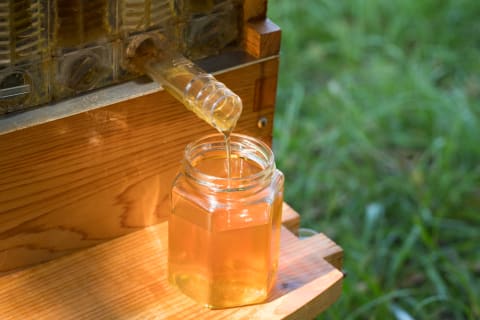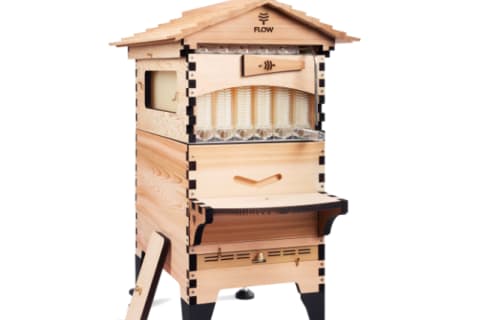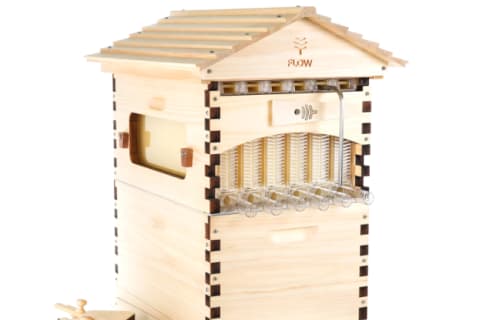We spoke to an inventor of the Flow Hive as well as a few backyard beekeepers to find out exactly how the product works, its pros and cons, and how to best use it to keep yourself (and your bees!) safe. To get honey out of a conventional beehive, you need to remove one of the hive’s frames at a time, brush off the bees, and carry the frame to a device called a centrifuge, which extracts honey from the honeycombs. From there, you sieve and filter your honey and put the frame back where you found it. It’s a time-consuming process that requires some patience. “I sat there one day and went, hang on, there must be a better way. Can’t we just tap the honey straight out of the hive and leave the bees be?” Anderson tells mbg on a call from his home in Australia. From there, Anderson and his father, Stuart, set out on a decades-long process to reinvent the beehive to simplify its extraction process. The result is the Flow Hive, which allows beekeepers to simply twist a handle and watch honey flow directly out, no centrifuge or disassembly required. The Flow Hive broke crowdfunding records when it first launched in 2015, and it now has 75,000 users in over 130 countries around the world. “The home beekeeping community is amazingly passionate about Flow Hive,” says Anderson. “I think what’s happened is it has created a whole new experience for backyard beekeepers. You can sit there with your family filling up jars of honey in a way that wasn’t possible before.” This is something that Paul Mackie and his daughter, Blythe, quickly figured out when they purchased their first Flow Hive a year and a half ago. Excited by the idea of harvesting their own honey, they realized just how much there was to learn about keeping bees before they could get to that step. As Paul put it to mbg, “If you buy a puppy, you want to learn how to keep the puppy alive. If you have bees, you now have 20,000 to 30,000 pets to take responsibility for.” After a successful first harvest season, the Mackies are now very involved in their local beekeeping network, which they often turn to for guidance and assistance. When getting started, “Find someone else who keeps bees because you’re going to have a ton of questions,” advises Mika Hardison, the founder of The Herban Bee and a beekeeper who is familiar with the Flow Hive but chooses to use a conventional setup. “Somebody who has had that experience already is just a great resource.” Hardison notes that each county also has its own rules about beekeeping, so you’ll need to look into those before setting up any system. “If you do not have experience with working with bees, you need to use your personal protective equipment, because you don’t know the temperament of those bees,” Hardison says of the importance of a protective suit. “You have no way of knowing when your hive is happy and what that sounds like versus when it’s a grouchy day and what that sounds like. When they’re missing something, when they have a disease, when their queen has died… All of these conditions create an environment where bees can be aggressive.” As such, Anderson notes, bees in the Flow Hive will need to have enough honey (or another food source) left in their hive to get them through colder months when they can’t gather as much food. For this reason, he doesn’t recommend extracting all of your hive’s honey at once and leaving the bees with nothing. “It’s best to get some local advice on how much honey you need to leave for your bees for the wintertime,” he says, since how much you leave will depend on your climate. The “windows” on the Flow Hive allow you to look in on your bees and see how much honey is left in their frames, making this process a bit easier. “As you get used to it, you can work out when it’s an appropriate time to harvest—and if you’re not sure, you can harvest just one frame of the hive and leave the rest,” he says. Once this process is complete, you stick a long key-shaped contraption into the outside of your hive to release its honey. “And then what happens is each cell inside the comb splits in two. That creates a zigzagging pathway for the honey to flow down into the trough at the bottom and out,” Anderson explains. Place a jar under the Flow Hive’s spigot, and with any luck, you’ll have a supply of fresh honey in minutes. The bees can then go on to rebuild the plastic frame and start the process over again. Most beehives can be tapped for honey in the summer and early fall months. But to ensure your hive stays healthy, you’ll want to check in on your bees regularly year-round. If you live in a colder climate, you’ll also want to insulate your hive and make sure it’s stocked up for winter so your bees survive the season. Again, sync up with your local beekeeping community for best practices about this, and be sure to check out the helpful resources on the Flow Hive site. “Last year, we got 9 liters out of our first harvest, and we started later in the season, so that was pretty cool,” Blythe says. “We were absolutely shocked,” adds Paul, remembering that the family anticipated filling two small jars and quickly had to run inside to get more when the honey just kept on flowing. As for how often you can harvest your frames, Anderson says it depends on a few factors. The health of your colony and the amount of food they have access to will affect how quickly bees can refill the frames with fresh honey. Keeping a close eye on your hive and planting plenty of pollinator-friendly flowers in your yard will increase your chance of multiple successful harvests. “When those two things align, you get an amazing amount of honey production,” he notes, saying that it’s not uncommon to see hives fill every two weeks during harvest season. Through the years, Flow Hive users have reported that their honey tastes more flavorful than any other honey they’ve tried. One 2017 study out of the University of Queensland proved they’re onto something; honey from the Flow Hive contained cleaner, fresher, and more floral characteristics than conventional honey. Anderson suspects that this rich flavor is thanks to the fact that Flow Hive honey doesn’t come in contact with any metals during the extraction phase. With a conventional setup, most beekeepers will also need to combine hive frames during extraction, mixing their honey together to cut down on processing time. Since the Flow Hive makes it easier to harvest one frame at a time, it also lets you get a taste of the nuances within each frame. Depending on when the frame was filled and the flowers your bees were exploring at that time of year, its honey might taste totally different. This is another unique appeal of beekeeping; it allows you to taste your local environment in a brand-new way. Keep in mind that you can’t add frames to a Flow Hive the way you can with a conventional hive, so once you make your purchase, you’re pretty locked into the size. Beyond producing more honey, seven-frame hives are larger and provide more insulation for bees in the winter, making them a popular pick for those living in cooler climates. The six-frame hives are lighter and easier to maneuver, so Anderson himself (who lives in Australia and doesn’t have to worry about chilly winters) uses those.
7-frame Flow Hive 2+
6-frame Flow Hive Classic
Flow Beekeeper Suit If you do end up diving deep into the world of beekeeping, you might find yourself inspired to make other changes to turn your yard into a more thriving ecosystem, like starting your own compost or designing a permaculture garden. After all, “through beekeeping,” Anderson muses, “we connect to the world which supports us and all life.” Emma received her B.A. in Environmental Science & Policy with a specialty in environmental communications from Duke University. In addition to penning over 1,000 mbg articles on topics from the water crisis in California to the rise of urban beekeeping, her work has appeared on Grist, Bloomberg News, Bustle, and Forbes. She’s spoken about the intersection of self-care and sustainability on podcasts and live events alongside environmental thought leaders like Marci Zaroff, Gay Browne, and Summer Rayne Oakes.






